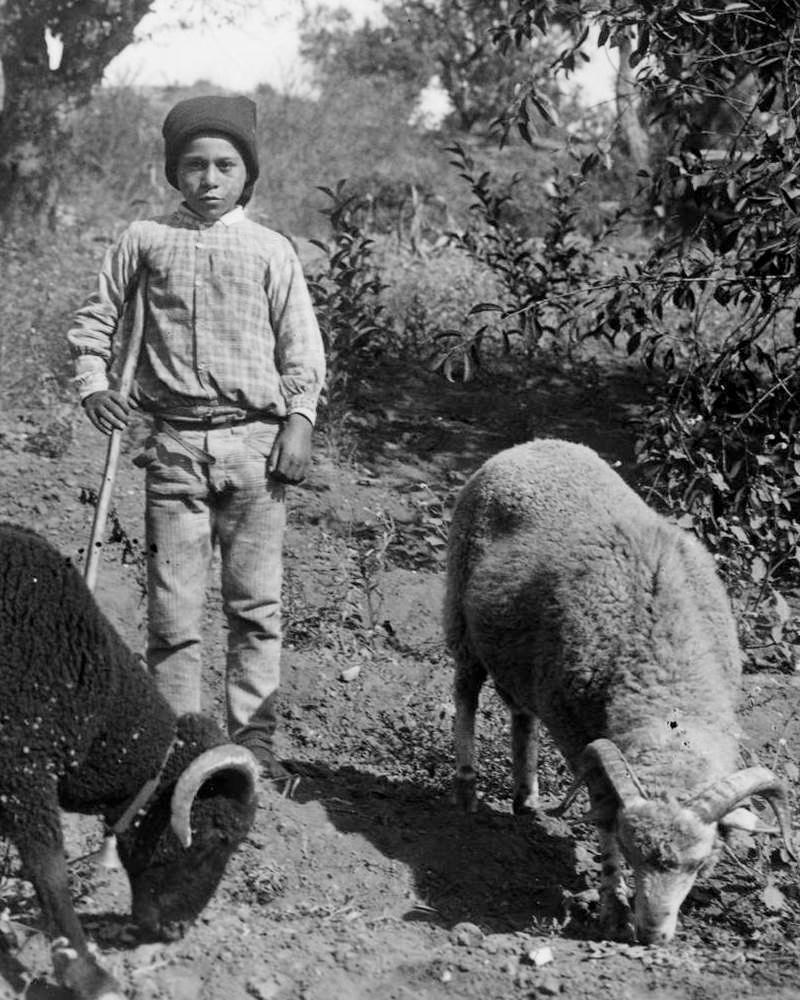
Portuguese Boys Work: Shephereds

Figure 1.--This photo shows a young shepherd in the countryside near Setubal. Sheperd boys were common in Europe, but the practice had begun to decline by the 20th cenury. The continuing practice in Portugal reflects the poverty in the country into modern times. We are not sure just when the photograph was taken, perhaps the 1930s. Portuguese boys wore long panys to a greater degree than most other boys. . .
|
|
Portugal is one of the poorer countries in Europe, although conditions have improved since the country entered the European Union. The country was primarily agricultural and children traditionally worked on farms. Boys might also work as shepherds. Wool is an important part of the Portuguese economy, but we have very little information on the history of the industry at this time. Wool was the primary favbric used for clothing in Roman times. The Moors introduced cotton to the Ibreraian Peninsula (8th century). We are unsure to what extent the western part of the Peninsula (modern Portugal) was affected. There was an important wool industry in both Portugal and Spain during medueval times. The Jews played an important part in the industry, but we are unsure how the industry was affected by the expulsion of the Jews (1490s). One reports indicates that the wool industry was mostly located in the livestock and border areas of Portugal (16th century). Some of the most important centers were: Covilhã, Gouveia, Seia, Oliveira do Hospital, Trancoso and Pinhel. This was the time that Portugal was building an empire. A century later, Portugal's overseas empire and trade ouposts were underseige by other European countries. This greatly reduced state income and the domestic economy was adversely affected by the resulting increased taxes. Dom Pedro II (1683-1706) played an important role in the country's wool insustry. His Chancellor of the Exchequer, the Count of Ericeira (1679), Luís de Meneses, attempted to promote the wool and textile industries. Some large weaving plants were built at this time, in Covilhã, Estremoz, Manteigas, Melo (Gouveia) and Lisbon. Most of the production was marketed in domestically and in Brazil. Most of the wool supplying the plants werte produced domestically. And children commonly were used as shepherds, commonly boys. Relatively few Portuguese attended school until the 20th century. And the Portuguese education system today is one iof the weakest in Europe. The sheep and goats which produce the wool often have bells around their necks and the tinkling helps the shepherds keep tack of the animals. Three of the best known Portuguese children are shepherds, the three shepherds children of Fatima. The children (Lucia Santos, her cousin Francisco de Marta and his his sister Jacinta) were born and raised in Fatima, a small village of Aljustrel in central Portugal. The children were 6-9 years old when they witnessed three visions (sporing abd summer 1917). The first vision was a lady who said she would tell them later of her identity (May 13, 1917). The children, led by Lucia, agreed to do as they were instructed. The Lady tiold the children that she would visit each month on the 13th day for the next 6 months. People made fun of them and Lucia's mother even beat her.
HBC

Navigate the Boys' Historical Clothing Web Site:
[Introduction]
[Biographies]
[Chronology]
[Clothing styles]
[Country]
[Photography]
[Bibliographies]
[Contributions]
[FAQs]
[Glossaries]
[Images]
[Links]
[Registration]
[Tools]
[Boys' Clothing Home]
Navigate the Boys' Historical Clothing Polish pages:
[Portuguese choirs]
[Portuguese movies]
[Portuguese orphanages]
[Portuguese school uniforms]
[Portuguese sailor suits]
[Portuguese youth groups]
Navigate the Boys' Historical Clothing Web Site:
[Return to the Main Portuguese activities pahe]
[Return to the Main Portuguese page]
[Return to the Main country page]
[Australia]
[Canada]
[England]
[France]
[Germany]
[Ireland]
[Italy]
[New Zealand]
[Poland]
[Scotland]
[United States]
Created: 2:54 AM 4/7/2009
Last updated: 5:02 AM 5/2/2011



